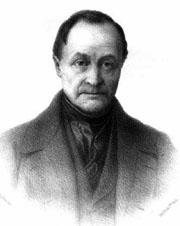 Karl Marx believed that history unfolded according to an underlying law.
Karl Marx believed that history unfolded according to an underlying law.Statistically speaking, it seems that things can only get worse. A study of the statistics of global terrorism concludes that attacks will become more severe in the future, and that an attack that kills as many people as the destruction of the World Trade Center on 11 September 2001 is likely within the next seven years1.
It all sounds very depressing and seems to imply, depending on your viewpoint, either that the 'war on terror' is essential or that it is futile. But can we really assert these things based on statistics alone?
Computer scientists Aaron Clauset and Maxwell Young of the University of New Mexico, Albuquerque, have analysed the data on terrorist attacks compiled by the National Memorial Institute for the Prevention of Terrorism in Oklahoma City. They say the numbers follow a 'power-law' relationship.
A graph of the number of attacks n plotted against their severity x (in terms of injuries and/or fatalities) reveals that n is roughly proportional to x -1.85. Put simply, this means that the frequency of attacks decreases as their size increases - which is what you'd expect - but also that this relationship holds for events ranging from those that injured or killed just a few people to those that, like the Nairobi car bomb in August 1998, produced over 5000 casualties.
Startling implications
This might sound like no more than a formal way of presenting the statistics, but the power-law relationship has startling implications. For example, Clauset and Young say that the statistics suggest a strong probability of an attack as devastating as that on the World Trade Center within seven years.
“So far as there are laws in history, laws are worth nothing and history is worth nothing.”
Friedrich Nietzsche
And the power-law relationship implies that the biggest terrorist attacks are not 'outliers': one-off events somehow different from the all-too-familiar suicide bombings that kill or maim just a few people. Instead, it suggests that they are somehow driven by the same underlying mechanism.
Similar power-law relationships between size and frequency apply to other phenomena, such as earthquakes and fluctuations in economic markets. This indicates that even the biggest, most infrequent earthquakes are created by the same processes that produce hordes of tiny ones, and that occasional market crashes are generated by the same internal dynamics of the marketplace that produce daily wobbles in stock prices. Analogously, Clauset and Young's study implies some kind of 'global dynamics' of terrorism.
Moreover, a power-law suggests something about that mechanism. If every terrorist attack were instigated independently of every other, their size-frequency relationship should obey the 'gaussian' statistics seen in coin-tossing experiments. In gaussian statistics, very big fluctuations are extremely rare - you will hardly ever observe ten heads and ninety tails when you toss a coin 100 times. Processes governed by power-law statistics, in contrast, seem to be interdependent. This makes them far more prone to big events, which is why giant tsunamis and market crashes do happen within a typical lifetime. Does this mean that terrorist attacks are interdependent in the same way?
Universal history
This touches on a deep, difficult and long-standing question that has divided historians for centuries: are there universal laws governing human history?
 Positivist philosopher Auguste Comte suggested that there are robust laws of social behaviour.
Positivist philosopher Auguste Comte suggested that there are robust laws of social behaviour.Immanuel Kant, writing in his essay Idea of a Universal History from a Cosmopolitan Point of View (1784), proposed that "Individual men, and even whole nations, little think, while they are pursuing their own purposes...that they are advancing unconsciously under the guidance of a purpose of nature which is unknown to them."
The idea that there are robust laws of social behaviour analogous to the laws of physics - laws which are beyond our power to change - is what underlay the 'positivist' philosophy of Auguste Comte in the 1830s. It moved Leo Tolstoy to ask: "What is the force that moves nations?" A belief in the 'law-like' unfolding of history and economics also provided the foundation of Karl Marx's theories, and it continues to inform the thinking of Marxist historians today.
In contrast, what one might call the 'Great Man' view of history, championed by Thomas Carlyle in the nineteenth century, holds that this sort of positivism is a chimera and that history is instead a much more contingent affair whose course is determined by the rise of powerful figures such as Napoleon and Hitler. Friedrich Nietzsche had a strong sympathy for this position: "So far as there are laws in history," he said, "laws are worth nothing and history is worth nothing."
So does global terrorism operate in a way that individual states or initiatives cannot hope to control, or can a concerted effort to eliminate it reshape the power-law statistics of attacks?
Deadly quarrels
British physicist Lewis Fry Richardson made a similar study between the 1920s to the 1950s. He collected data on "deadly quarrels": fatal conflicts ranging from small local skirmishes to world wars. He found that their size-frequency distribution also followed a power law.
When Richardson published his findings in 1960, they seemed to convey a very gloomy message: wars were apparently getting bigger, and the two biggest events had occurred only 25 years apart in the very recent past. It looked as though the world was headed for another, even more deadly war. But in reality, changes in global politics altered the very nature of wars. They did not by any means go away, but they are now fought for different reasons and in different ways.
Clauset and Young are careful to point out that their own doom-laden forecasts assume that the power-law relationship for terrorism, based on 36 years of data, will continue to hold in the coming decades.
ADVERTISEMENT
Although it may be tempting for people to read the predictions as a form of statistically driven determinism, we must remember that statistics do not themselves have any motive agency in the real world. For example, when eighteenth-century statisticians discovered that the annual frequency of crimes obeyed gaussian statistics, some interpreted this as evidence for a kind of 'social force' that compelled some people to commit crimes.
It is sadly possible, of course, that Clauset and Young's predictions will come to pass. But it is worth bearing in mind that several apparent power-law statistics in social phenomena have turned out, on closer inspection, to have natural cut-off points that preclude very large events2. And whatever the case, we should be wary of predictions based purely on statistics. History teaches us that it is possible, sometimes, to change the rules that generate them.
-
References
- Clauset A. & Young M. Preprint http://xxx.arxiv.org/abs/physics/0502014 (2005).
- Amaral L. A. N., Scala A., Barthélémy M. & Stanley H. E. Proc. Natl Acad. Sci. USA , 97. 11149 - 11152 (2000). | Article | PubMed | ChemPort |

